Cerebrovascular Accident (CVA) in Australia: Analysis and Discussion
VerifiedAdded on 2022/09/07
|16
|4268
|27
Essay
AI Summary
This essay provides a comprehensive analysis of cerebrovascular accidents (CVA) in Australia. It begins by highlighting the significant impact of CVA as a leading cause of mortality and disability, particularly among the elderly and indigenous populations. The essay delves into the prevalence, mortality rates, and financial burden of CVA within the Australian context, examining socio-demographic characteristics of affected individuals, including risk factors such as hypertension, diabetes, smoking, and obesity. It explores the level of disability experienced by CVA patients, including motor impairments, sensory disturbances, and aphasia, as well as the impact on their daily lives. Furthermore, the essay evaluates the impact of CVA on individuals, families, and the healthcare system, including financial costs and emotional consequences. The role of nurses in CVA assessment is discussed, along with recommendations for aged care support services available to stroke patients, such as the Stroke Foundation and Aphasia Victoria, providing a holistic overview of CVA management and support in Australia.
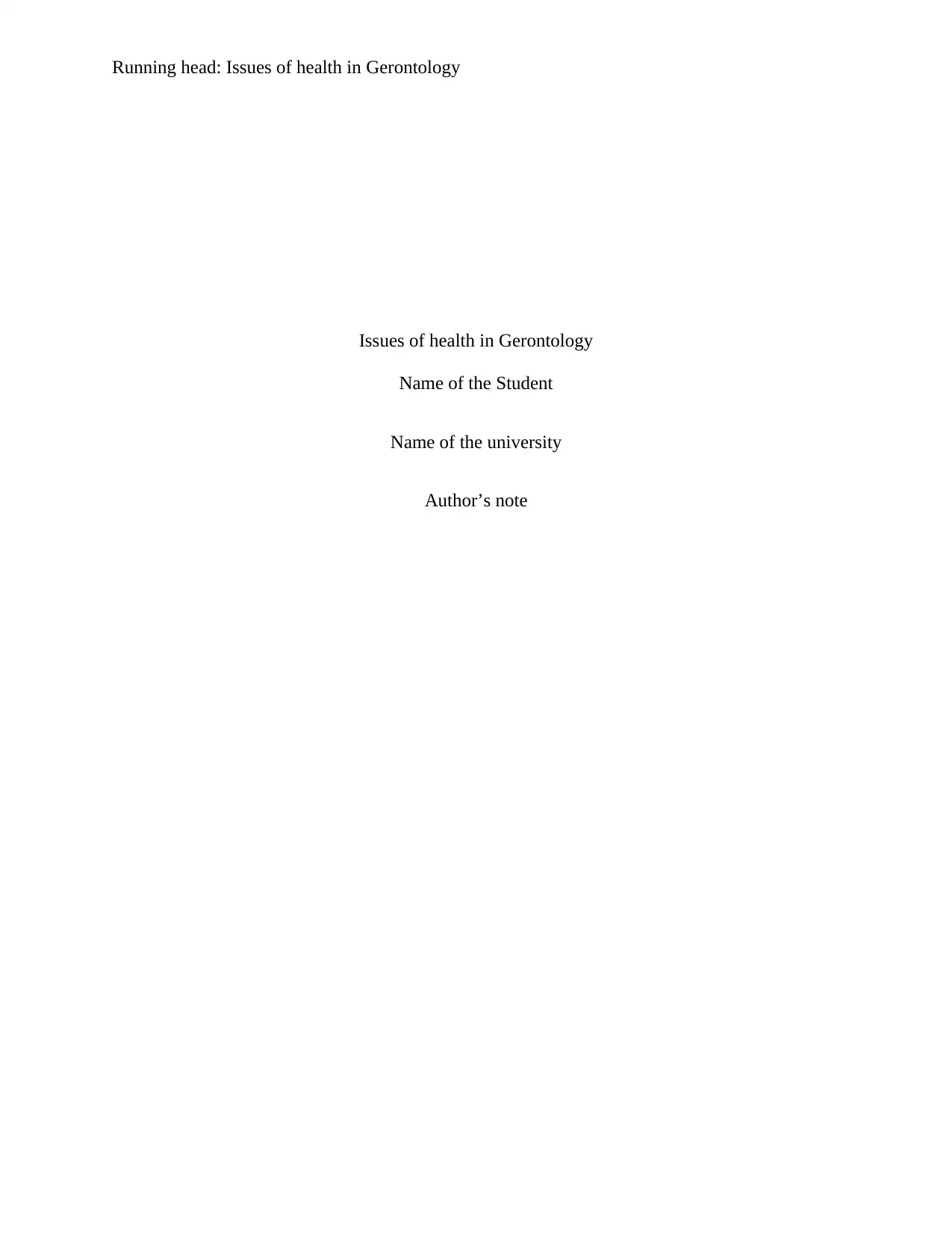
Running head: Issues of health in Gerontology
Issues of health in Gerontology
Name of the Student
Name of the university
Author’s note
Issues of health in Gerontology
Name of the Student
Name of the university
Author’s note
Paraphrase This Document
Need a fresh take? Get an instant paraphrase of this document with our AI Paraphraser
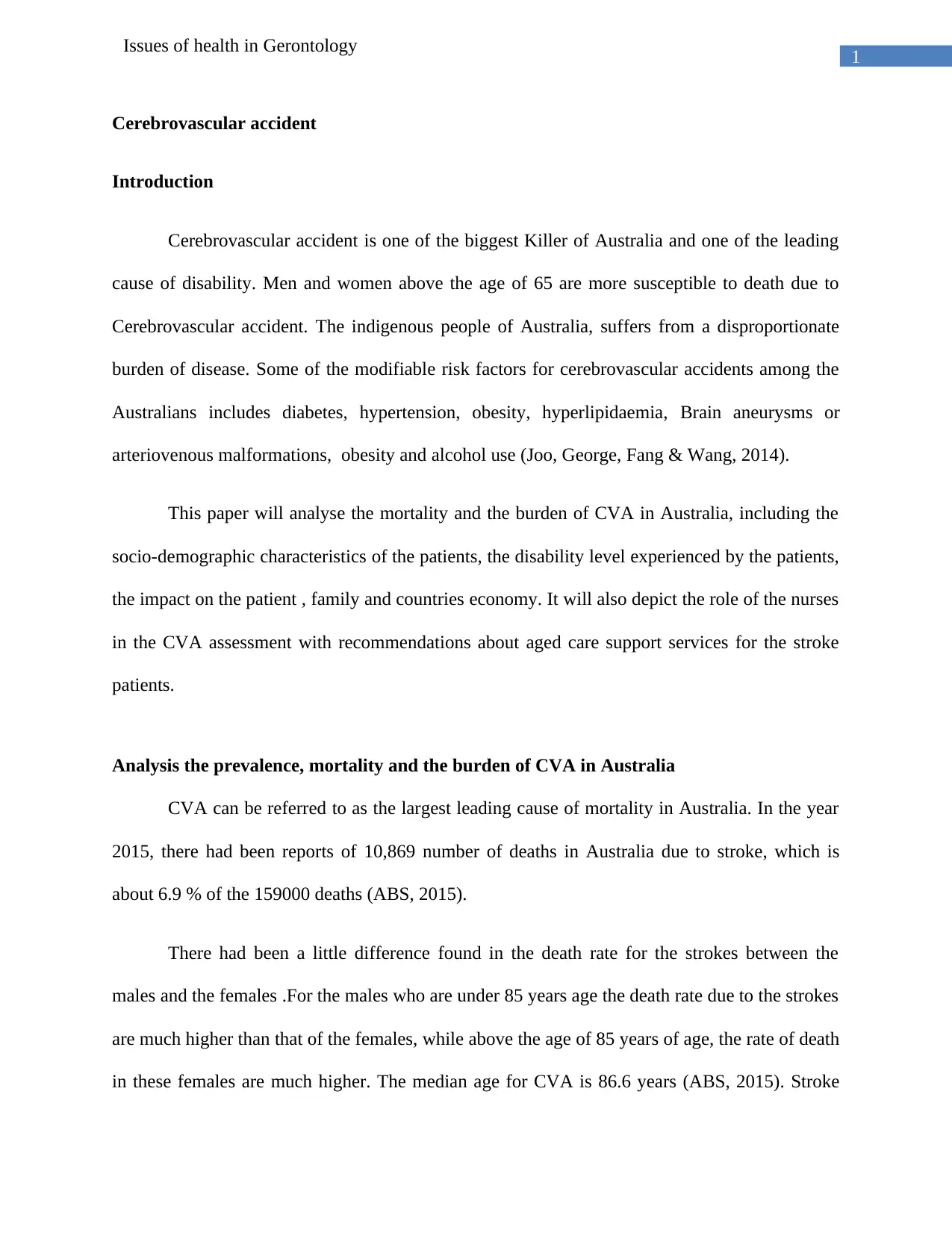
1
Issues of health in Gerontology
Cerebrovascular accident
Introduction
Cerebrovascular accident is one of the biggest Killer of Australia and one of the leading
cause of disability. Men and women above the age of 65 are more susceptible to death due to
Cerebrovascular accident. The indigenous people of Australia, suffers from a disproportionate
burden of disease. Some of the modifiable risk factors for cerebrovascular accidents among the
Australians includes diabetes, hypertension, obesity, hyperlipidaemia, Brain aneurysms or
arteriovenous malformations, obesity and alcohol use (Joo, George, Fang & Wang, 2014).
This paper will analyse the mortality and the burden of CVA in Australia, including the
socio-demographic characteristics of the patients, the disability level experienced by the patients,
the impact on the patient , family and countries economy. It will also depict the role of the nurses
in the CVA assessment with recommendations about aged care support services for the stroke
patients.
Analysis the prevalence, mortality and the burden of CVA in Australia
CVA can be referred to as the largest leading cause of mortality in Australia. In the year
2015, there had been reports of 10,869 number of deaths in Australia due to stroke, which is
about 6.9 % of the 159000 deaths (ABS, 2015).
There had been a little difference found in the death rate for the strokes between the
males and the females .For the males who are under 85 years age the death rate due to the strokes
are much higher than that of the females, while above the age of 85 years of age, the rate of death
in these females are much higher. The median age for CVA is 86.6 years (ABS, 2015). Stroke
Issues of health in Gerontology
Cerebrovascular accident
Introduction
Cerebrovascular accident is one of the biggest Killer of Australia and one of the leading
cause of disability. Men and women above the age of 65 are more susceptible to death due to
Cerebrovascular accident. The indigenous people of Australia, suffers from a disproportionate
burden of disease. Some of the modifiable risk factors for cerebrovascular accidents among the
Australians includes diabetes, hypertension, obesity, hyperlipidaemia, Brain aneurysms or
arteriovenous malformations, obesity and alcohol use (Joo, George, Fang & Wang, 2014).
This paper will analyse the mortality and the burden of CVA in Australia, including the
socio-demographic characteristics of the patients, the disability level experienced by the patients,
the impact on the patient , family and countries economy. It will also depict the role of the nurses
in the CVA assessment with recommendations about aged care support services for the stroke
patients.
Analysis the prevalence, mortality and the burden of CVA in Australia
CVA can be referred to as the largest leading cause of mortality in Australia. In the year
2015, there had been reports of 10,869 number of deaths in Australia due to stroke, which is
about 6.9 % of the 159000 deaths (ABS, 2015).
There had been a little difference found in the death rate for the strokes between the
males and the females .For the males who are under 85 years age the death rate due to the strokes
are much higher than that of the females, while above the age of 85 years of age, the rate of death
in these females are much higher. The median age for CVA is 86.6 years (ABS, 2015). Stroke
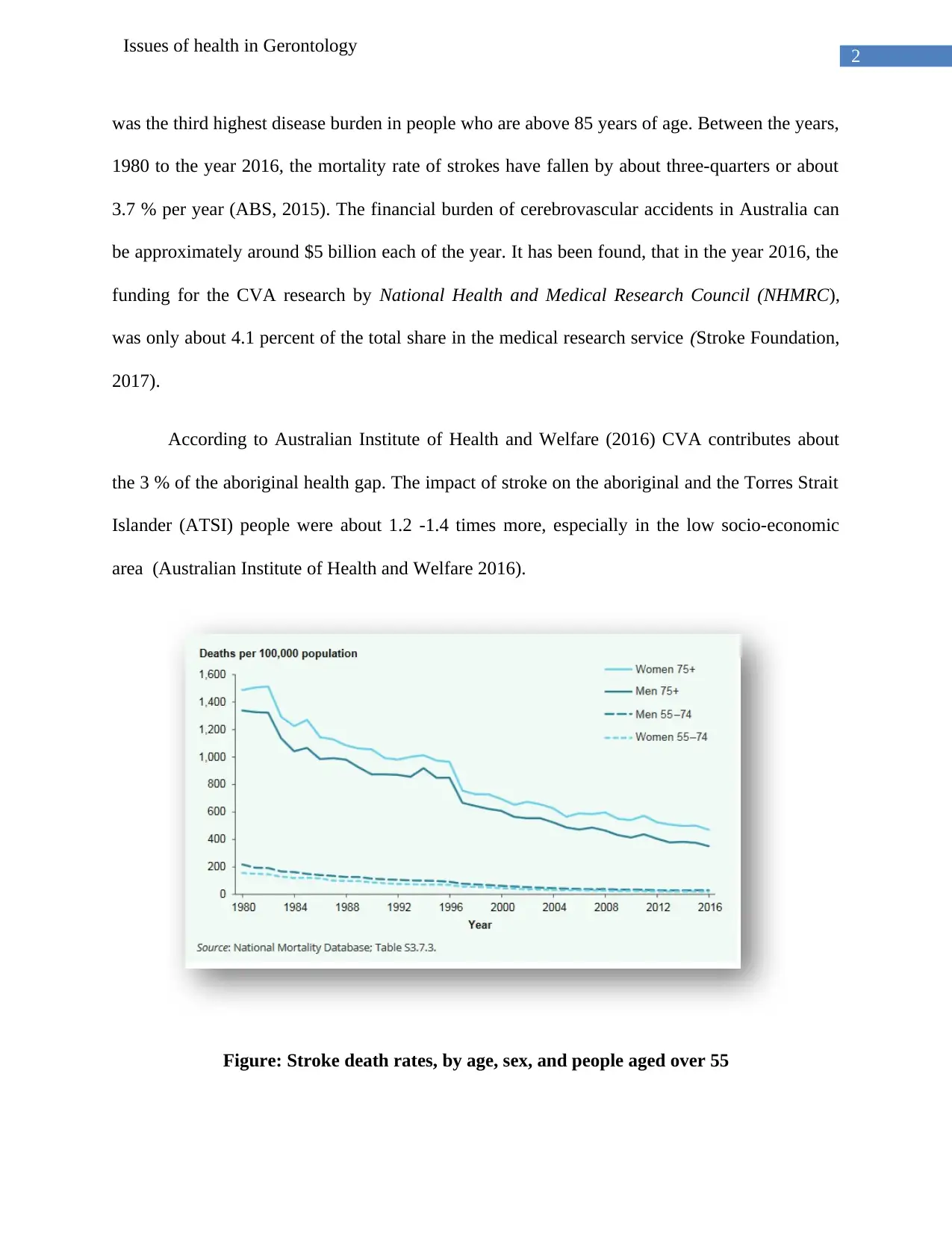
2
Issues of health in Gerontology
was the third highest disease burden in people who are above 85 years of age. Between the years,
1980 to the year 2016, the mortality rate of strokes have fallen by about three-quarters or about
3.7 % per year (ABS, 2015). The financial burden of cerebrovascular accidents in Australia can
be approximately around $5 billion each of the year. It has been found, that in the year 2016, the
funding for the CVA research by National Health and Medical Research Council (NHMRC),
was only about 4.1 percent of the total share in the medical research service (Stroke Foundation,
2017).
According to Australian Institute of Health and Welfare (2016) CVA contributes about
the 3 % of the aboriginal health gap. The impact of stroke on the aboriginal and the Torres Strait
Islander (ATSI) people were about 1.2 -1.4 times more, especially in the low socio-economic
area (Australian Institute of Health and Welfare 2016).
Figure: Stroke death rates, by age, sex, and people aged over 55
Issues of health in Gerontology
was the third highest disease burden in people who are above 85 years of age. Between the years,
1980 to the year 2016, the mortality rate of strokes have fallen by about three-quarters or about
3.7 % per year (ABS, 2015). The financial burden of cerebrovascular accidents in Australia can
be approximately around $5 billion each of the year. It has been found, that in the year 2016, the
funding for the CVA research by National Health and Medical Research Council (NHMRC),
was only about 4.1 percent of the total share in the medical research service (Stroke Foundation,
2017).
According to Australian Institute of Health and Welfare (2016) CVA contributes about
the 3 % of the aboriginal health gap. The impact of stroke on the aboriginal and the Torres Strait
Islander (ATSI) people were about 1.2 -1.4 times more, especially in the low socio-economic
area (Australian Institute of Health and Welfare 2016).
Figure: Stroke death rates, by age, sex, and people aged over 55
⊘ This is a preview!⊘
Do you want full access?
Subscribe today to unlock all pages.

Trusted by 1+ million students worldwide
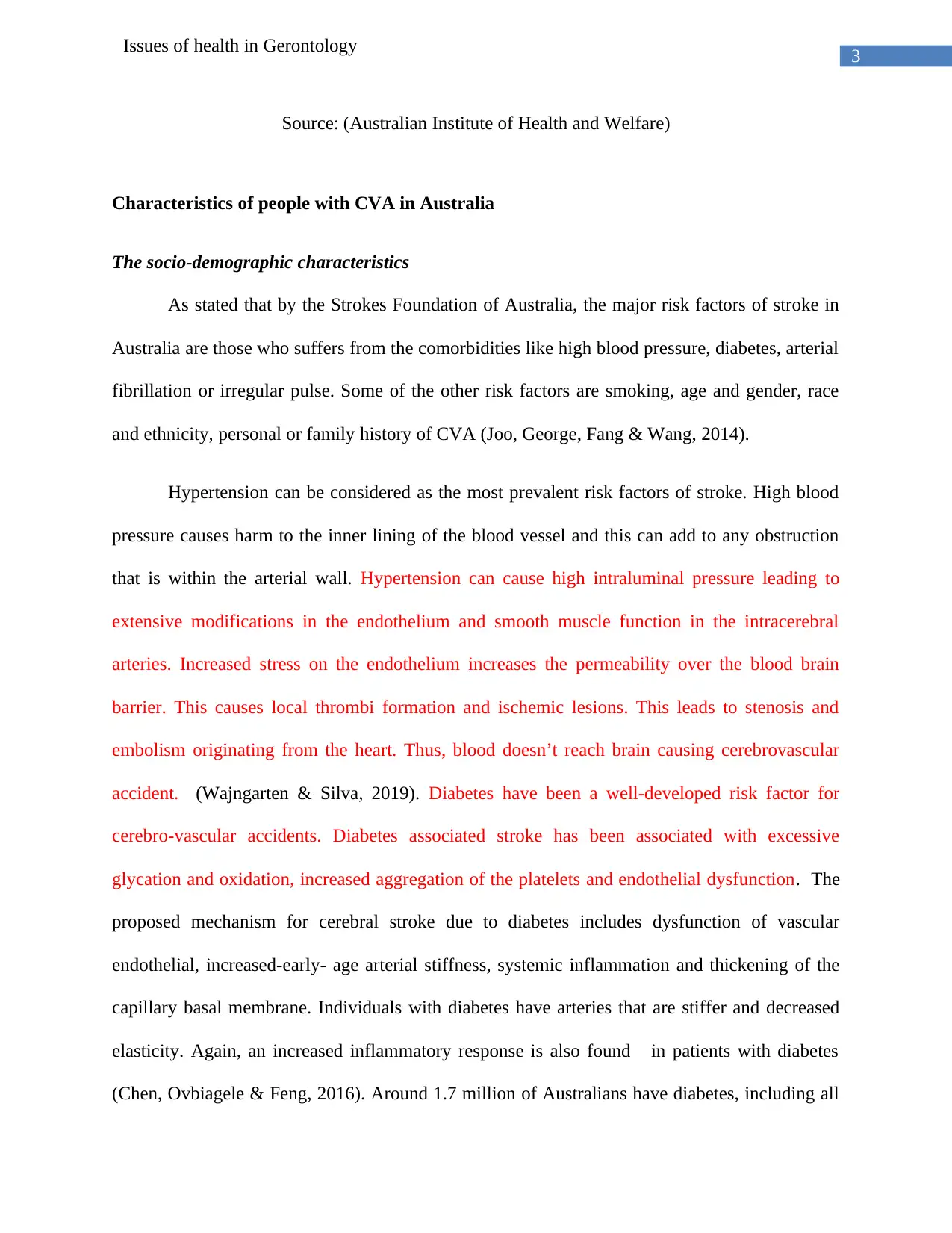
3
Issues of health in Gerontology
Source: (Australian Institute of Health and Welfare)
Characteristics of people with CVA in Australia
The socio-demographic characteristics
As stated that by the Strokes Foundation of Australia, the major risk factors of stroke in
Australia are those who suffers from the comorbidities like high blood pressure, diabetes, arterial
fibrillation or irregular pulse. Some of the other risk factors are smoking, age and gender, race
and ethnicity, personal or family history of CVA (Joo, George, Fang & Wang, 2014).
Hypertension can be considered as the most prevalent risk factors of stroke. High blood
pressure causes harm to the inner lining of the blood vessel and this can add to any obstruction
that is within the arterial wall. Hypertension can cause high intraluminal pressure leading to
extensive modifications in the endothelium and smooth muscle function in the intracerebral
arteries. Increased stress on the endothelium increases the permeability over the blood brain
barrier. This causes local thrombi formation and ischemic lesions. This leads to stenosis and
embolism originating from the heart. Thus, blood doesn’t reach brain causing cerebrovascular
accident. (Wajngarten & Silva, 2019). Diabetes have been a well-developed risk factor for
cerebro-vascular accidents. Diabetes associated stroke has been associated with excessive
glycation and oxidation, increased aggregation of the platelets and endothelial dysfunction. The
proposed mechanism for cerebral stroke due to diabetes includes dysfunction of vascular
endothelial, increased-early- age arterial stiffness, systemic inflammation and thickening of the
capillary basal membrane. Individuals with diabetes have arteries that are stiffer and decreased
elasticity. Again, an increased inflammatory response is also found in patients with diabetes
(Chen, Ovbiagele & Feng, 2016). Around 1.7 million of Australians have diabetes, including all
Issues of health in Gerontology
Source: (Australian Institute of Health and Welfare)
Characteristics of people with CVA in Australia
The socio-demographic characteristics
As stated that by the Strokes Foundation of Australia, the major risk factors of stroke in
Australia are those who suffers from the comorbidities like high blood pressure, diabetes, arterial
fibrillation or irregular pulse. Some of the other risk factors are smoking, age and gender, race
and ethnicity, personal or family history of CVA (Joo, George, Fang & Wang, 2014).
Hypertension can be considered as the most prevalent risk factors of stroke. High blood
pressure causes harm to the inner lining of the blood vessel and this can add to any obstruction
that is within the arterial wall. Hypertension can cause high intraluminal pressure leading to
extensive modifications in the endothelium and smooth muscle function in the intracerebral
arteries. Increased stress on the endothelium increases the permeability over the blood brain
barrier. This causes local thrombi formation and ischemic lesions. This leads to stenosis and
embolism originating from the heart. Thus, blood doesn’t reach brain causing cerebrovascular
accident. (Wajngarten & Silva, 2019). Diabetes have been a well-developed risk factor for
cerebro-vascular accidents. Diabetes associated stroke has been associated with excessive
glycation and oxidation, increased aggregation of the platelets and endothelial dysfunction. The
proposed mechanism for cerebral stroke due to diabetes includes dysfunction of vascular
endothelial, increased-early- age arterial stiffness, systemic inflammation and thickening of the
capillary basal membrane. Individuals with diabetes have arteries that are stiffer and decreased
elasticity. Again, an increased inflammatory response is also found in patients with diabetes
(Chen, Ovbiagele & Feng, 2016). Around 1.7 million of Australians have diabetes, including all
Paraphrase This Document
Need a fresh take? Get an instant paraphrase of this document with our AI Paraphraser
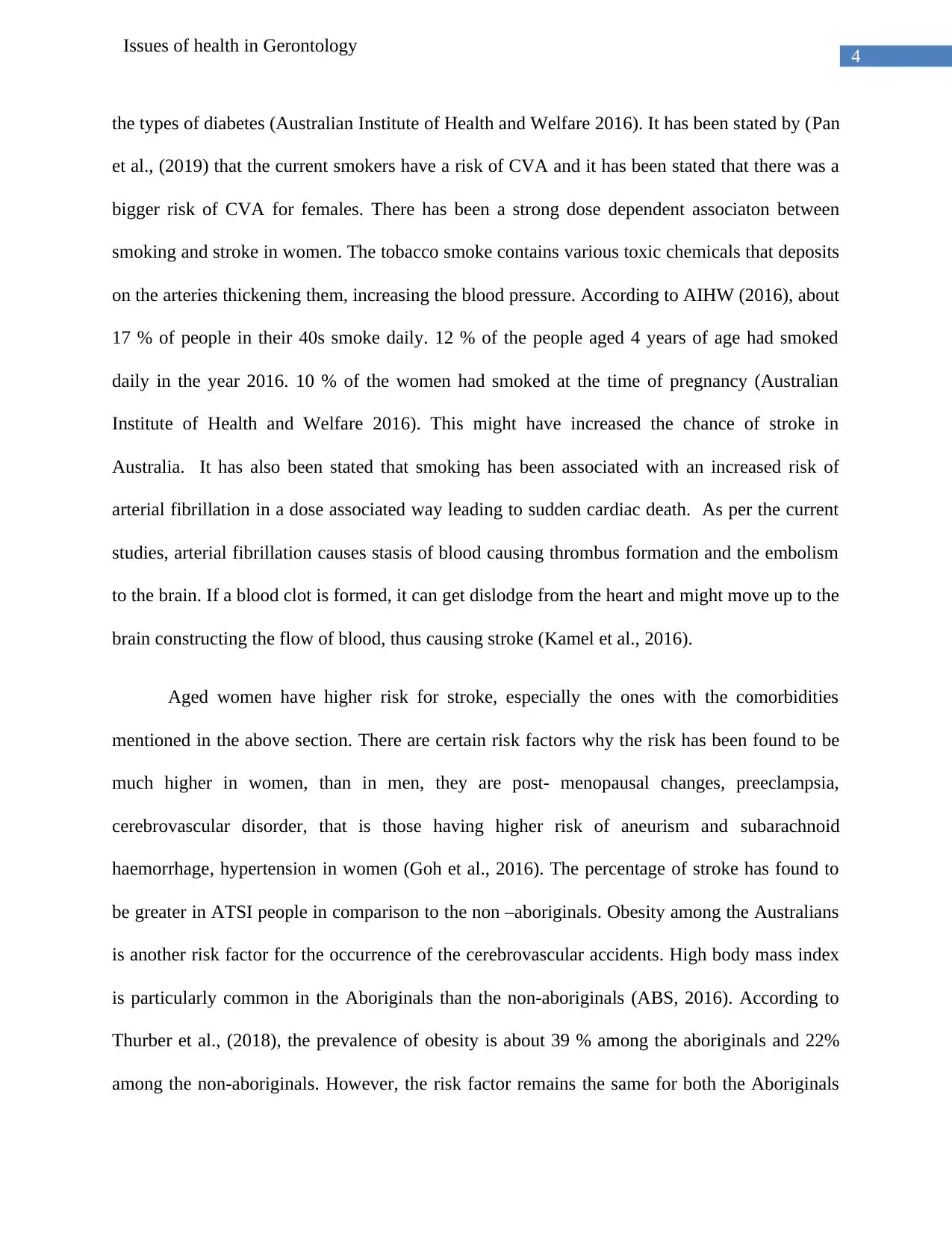
4
Issues of health in Gerontology
the types of diabetes (Australian Institute of Health and Welfare 2016). It has been stated by (Pan
et al., (2019) that the current smokers have a risk of CVA and it has been stated that there was a
bigger risk of CVA for females. There has been a strong dose dependent associaton between
smoking and stroke in women. The tobacco smoke contains various toxic chemicals that deposits
on the arteries thickening them, increasing the blood pressure. According to AIHW (2016), about
17 % of people in their 40s smoke daily. 12 % of the people aged 4 years of age had smoked
daily in the year 2016. 10 % of the women had smoked at the time of pregnancy (Australian
Institute of Health and Welfare 2016). This might have increased the chance of stroke in
Australia. It has also been stated that smoking has been associated with an increased risk of
arterial fibrillation in a dose associated way leading to sudden cardiac death. As per the current
studies, arterial fibrillation causes stasis of blood causing thrombus formation and the embolism
to the brain. If a blood clot is formed, it can get dislodge from the heart and might move up to the
brain constructing the flow of blood, thus causing stroke (Kamel et al., 2016).
Aged women have higher risk for stroke, especially the ones with the comorbidities
mentioned in the above section. There are certain risk factors why the risk has been found to be
much higher in women, than in men, they are post- menopausal changes, preeclampsia,
cerebrovascular disorder, that is those having higher risk of aneurism and subarachnoid
haemorrhage, hypertension in women (Goh et al., 2016). The percentage of stroke has found to
be greater in ATSI people in comparison to the non –aboriginals. Obesity among the Australians
is another risk factor for the occurrence of the cerebrovascular accidents. High body mass index
is particularly common in the Aboriginals than the non-aboriginals (ABS, 2016). According to
Thurber et al., (2018), the prevalence of obesity is about 39 % among the aboriginals and 22%
among the non-aboriginals. However, the risk factor remains the same for both the Aboriginals
Issues of health in Gerontology
the types of diabetes (Australian Institute of Health and Welfare 2016). It has been stated by (Pan
et al., (2019) that the current smokers have a risk of CVA and it has been stated that there was a
bigger risk of CVA for females. There has been a strong dose dependent associaton between
smoking and stroke in women. The tobacco smoke contains various toxic chemicals that deposits
on the arteries thickening them, increasing the blood pressure. According to AIHW (2016), about
17 % of people in their 40s smoke daily. 12 % of the people aged 4 years of age had smoked
daily in the year 2016. 10 % of the women had smoked at the time of pregnancy (Australian
Institute of Health and Welfare 2016). This might have increased the chance of stroke in
Australia. It has also been stated that smoking has been associated with an increased risk of
arterial fibrillation in a dose associated way leading to sudden cardiac death. As per the current
studies, arterial fibrillation causes stasis of blood causing thrombus formation and the embolism
to the brain. If a blood clot is formed, it can get dislodge from the heart and might move up to the
brain constructing the flow of blood, thus causing stroke (Kamel et al., 2016).
Aged women have higher risk for stroke, especially the ones with the comorbidities
mentioned in the above section. There are certain risk factors why the risk has been found to be
much higher in women, than in men, they are post- menopausal changes, preeclampsia,
cerebrovascular disorder, that is those having higher risk of aneurism and subarachnoid
haemorrhage, hypertension in women (Goh et al., 2016). The percentage of stroke has found to
be greater in ATSI people in comparison to the non –aboriginals. Obesity among the Australians
is another risk factor for the occurrence of the cerebrovascular accidents. High body mass index
is particularly common in the Aboriginals than the non-aboriginals (ABS, 2016). According to
Thurber et al., (2018), the prevalence of obesity is about 39 % among the aboriginals and 22%
among the non-aboriginals. However, the risk factor remains the same for both the Aboriginals
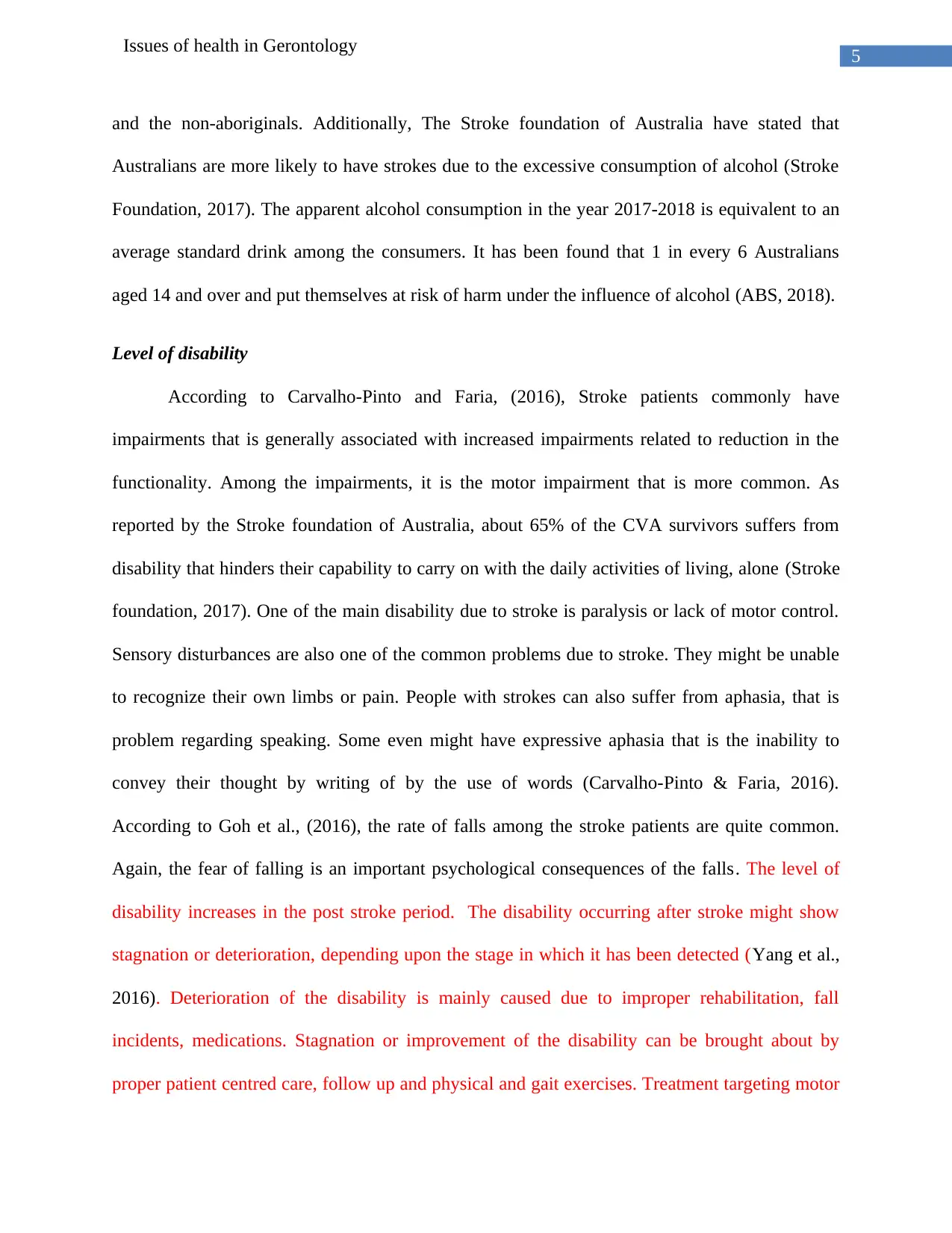
5
Issues of health in Gerontology
and the non-aboriginals. Additionally, The Stroke foundation of Australia have stated that
Australians are more likely to have strokes due to the excessive consumption of alcohol (Stroke
Foundation, 2017). The apparent alcohol consumption in the year 2017-2018 is equivalent to an
average standard drink among the consumers. It has been found that 1 in every 6 Australians
aged 14 and over and put themselves at risk of harm under the influence of alcohol (ABS, 2018).
Level of disability
According to Carvalho-Pinto and Faria, (2016), Stroke patients commonly have
impairments that is generally associated with increased impairments related to reduction in the
functionality. Among the impairments, it is the motor impairment that is more common. As
reported by the Stroke foundation of Australia, about 65% of the CVA survivors suffers from
disability that hinders their capability to carry on with the daily activities of living, alone (Stroke
foundation, 2017). One of the main disability due to stroke is paralysis or lack of motor control.
Sensory disturbances are also one of the common problems due to stroke. They might be unable
to recognize their own limbs or pain. People with strokes can also suffer from aphasia, that is
problem regarding speaking. Some even might have expressive aphasia that is the inability to
convey their thought by writing of by the use of words (Carvalho-Pinto & Faria, 2016).
According to Goh et al., (2016), the rate of falls among the stroke patients are quite common.
Again, the fear of falling is an important psychological consequences of the falls. The level of
disability increases in the post stroke period. The disability occurring after stroke might show
stagnation or deterioration, depending upon the stage in which it has been detected (Yang et al.,
2016). Deterioration of the disability is mainly caused due to improper rehabilitation, fall
incidents, medications. Stagnation or improvement of the disability can be brought about by
proper patient centred care, follow up and physical and gait exercises. Treatment targeting motor
Issues of health in Gerontology
and the non-aboriginals. Additionally, The Stroke foundation of Australia have stated that
Australians are more likely to have strokes due to the excessive consumption of alcohol (Stroke
Foundation, 2017). The apparent alcohol consumption in the year 2017-2018 is equivalent to an
average standard drink among the consumers. It has been found that 1 in every 6 Australians
aged 14 and over and put themselves at risk of harm under the influence of alcohol (ABS, 2018).
Level of disability
According to Carvalho-Pinto and Faria, (2016), Stroke patients commonly have
impairments that is generally associated with increased impairments related to reduction in the
functionality. Among the impairments, it is the motor impairment that is more common. As
reported by the Stroke foundation of Australia, about 65% of the CVA survivors suffers from
disability that hinders their capability to carry on with the daily activities of living, alone (Stroke
foundation, 2017). One of the main disability due to stroke is paralysis or lack of motor control.
Sensory disturbances are also one of the common problems due to stroke. They might be unable
to recognize their own limbs or pain. People with strokes can also suffer from aphasia, that is
problem regarding speaking. Some even might have expressive aphasia that is the inability to
convey their thought by writing of by the use of words (Carvalho-Pinto & Faria, 2016).
According to Goh et al., (2016), the rate of falls among the stroke patients are quite common.
Again, the fear of falling is an important psychological consequences of the falls. The level of
disability increases in the post stroke period. The disability occurring after stroke might show
stagnation or deterioration, depending upon the stage in which it has been detected (Yang et al.,
2016). Deterioration of the disability is mainly caused due to improper rehabilitation, fall
incidents, medications. Stagnation or improvement of the disability can be brought about by
proper patient centred care, follow up and physical and gait exercises. Treatment targeting motor
⊘ This is a preview!⊘
Do you want full access?
Subscribe today to unlock all pages.

Trusted by 1+ million students worldwide
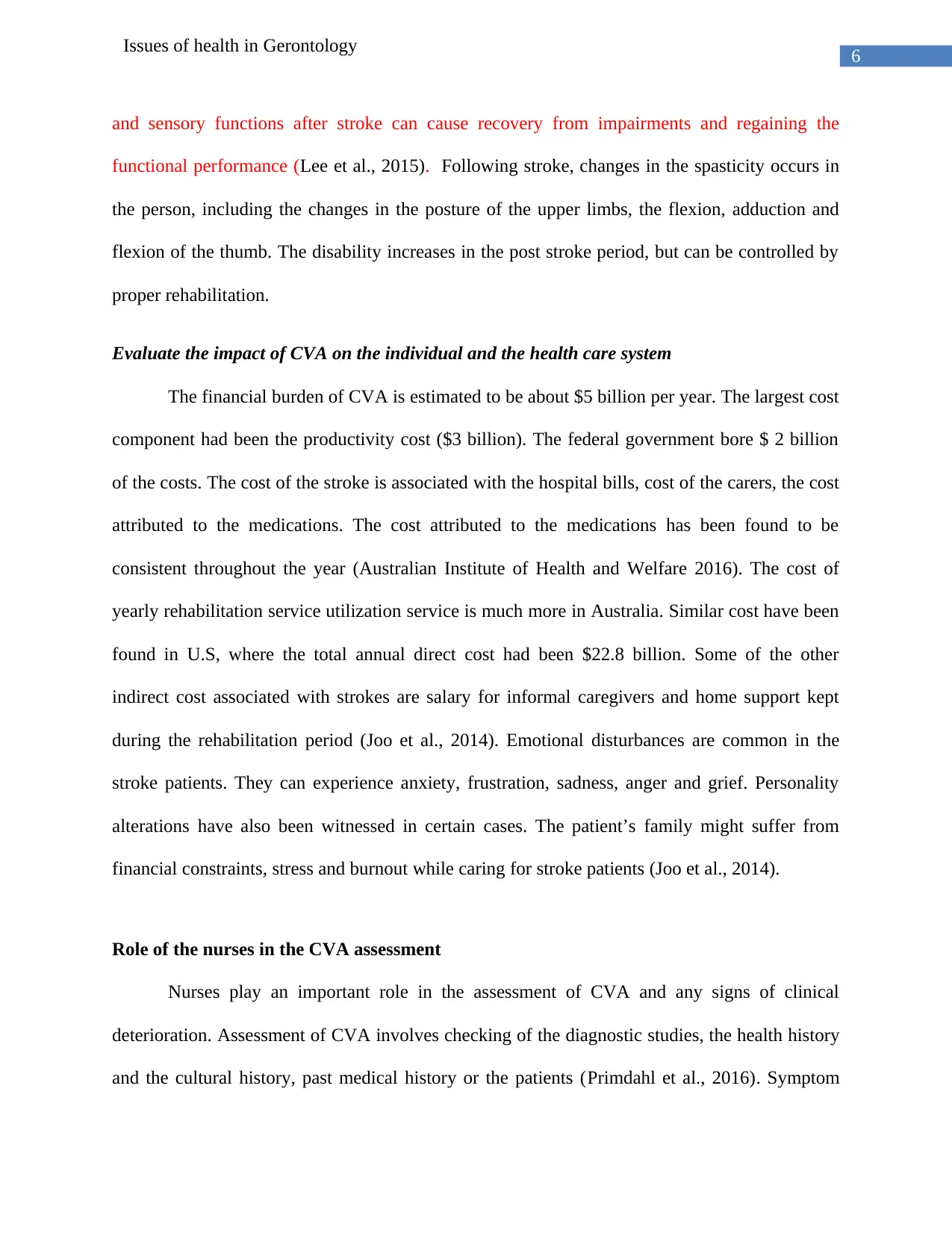
6
Issues of health in Gerontology
and sensory functions after stroke can cause recovery from impairments and regaining the
functional performance (Lee et al., 2015). Following stroke, changes in the spasticity occurs in
the person, including the changes in the posture of the upper limbs, the flexion, adduction and
flexion of the thumb. The disability increases in the post stroke period, but can be controlled by
proper rehabilitation.
Evaluate the impact of CVA on the individual and the health care system
The financial burden of CVA is estimated to be about $5 billion per year. The largest cost
component had been the productivity cost ($3 billion). The federal government bore $ 2 billion
of the costs. The cost of the stroke is associated with the hospital bills, cost of the carers, the cost
attributed to the medications. The cost attributed to the medications has been found to be
consistent throughout the year (Australian Institute of Health and Welfare 2016). The cost of
yearly rehabilitation service utilization service is much more in Australia. Similar cost have been
found in U.S, where the total annual direct cost had been $22.8 billion. Some of the other
indirect cost associated with strokes are salary for informal caregivers and home support kept
during the rehabilitation period (Joo et al., 2014). Emotional disturbances are common in the
stroke patients. They can experience anxiety, frustration, sadness, anger and grief. Personality
alterations have also been witnessed in certain cases. The patient’s family might suffer from
financial constraints, stress and burnout while caring for stroke patients (Joo et al., 2014).
Role of the nurses in the CVA assessment
Nurses play an important role in the assessment of CVA and any signs of clinical
deterioration. Assessment of CVA involves checking of the diagnostic studies, the health history
and the cultural history, past medical history or the patients (Primdahl et al., 2016). Symptom
Issues of health in Gerontology
and sensory functions after stroke can cause recovery from impairments and regaining the
functional performance (Lee et al., 2015). Following stroke, changes in the spasticity occurs in
the person, including the changes in the posture of the upper limbs, the flexion, adduction and
flexion of the thumb. The disability increases in the post stroke period, but can be controlled by
proper rehabilitation.
Evaluate the impact of CVA on the individual and the health care system
The financial burden of CVA is estimated to be about $5 billion per year. The largest cost
component had been the productivity cost ($3 billion). The federal government bore $ 2 billion
of the costs. The cost of the stroke is associated with the hospital bills, cost of the carers, the cost
attributed to the medications. The cost attributed to the medications has been found to be
consistent throughout the year (Australian Institute of Health and Welfare 2016). The cost of
yearly rehabilitation service utilization service is much more in Australia. Similar cost have been
found in U.S, where the total annual direct cost had been $22.8 billion. Some of the other
indirect cost associated with strokes are salary for informal caregivers and home support kept
during the rehabilitation period (Joo et al., 2014). Emotional disturbances are common in the
stroke patients. They can experience anxiety, frustration, sadness, anger and grief. Personality
alterations have also been witnessed in certain cases. The patient’s family might suffer from
financial constraints, stress and burnout while caring for stroke patients (Joo et al., 2014).
Role of the nurses in the CVA assessment
Nurses play an important role in the assessment of CVA and any signs of clinical
deterioration. Assessment of CVA involves checking of the diagnostic studies, the health history
and the cultural history, past medical history or the patients (Primdahl et al., 2016). Symptom
Paraphrase This Document
Need a fresh take? Get an instant paraphrase of this document with our AI Paraphraser
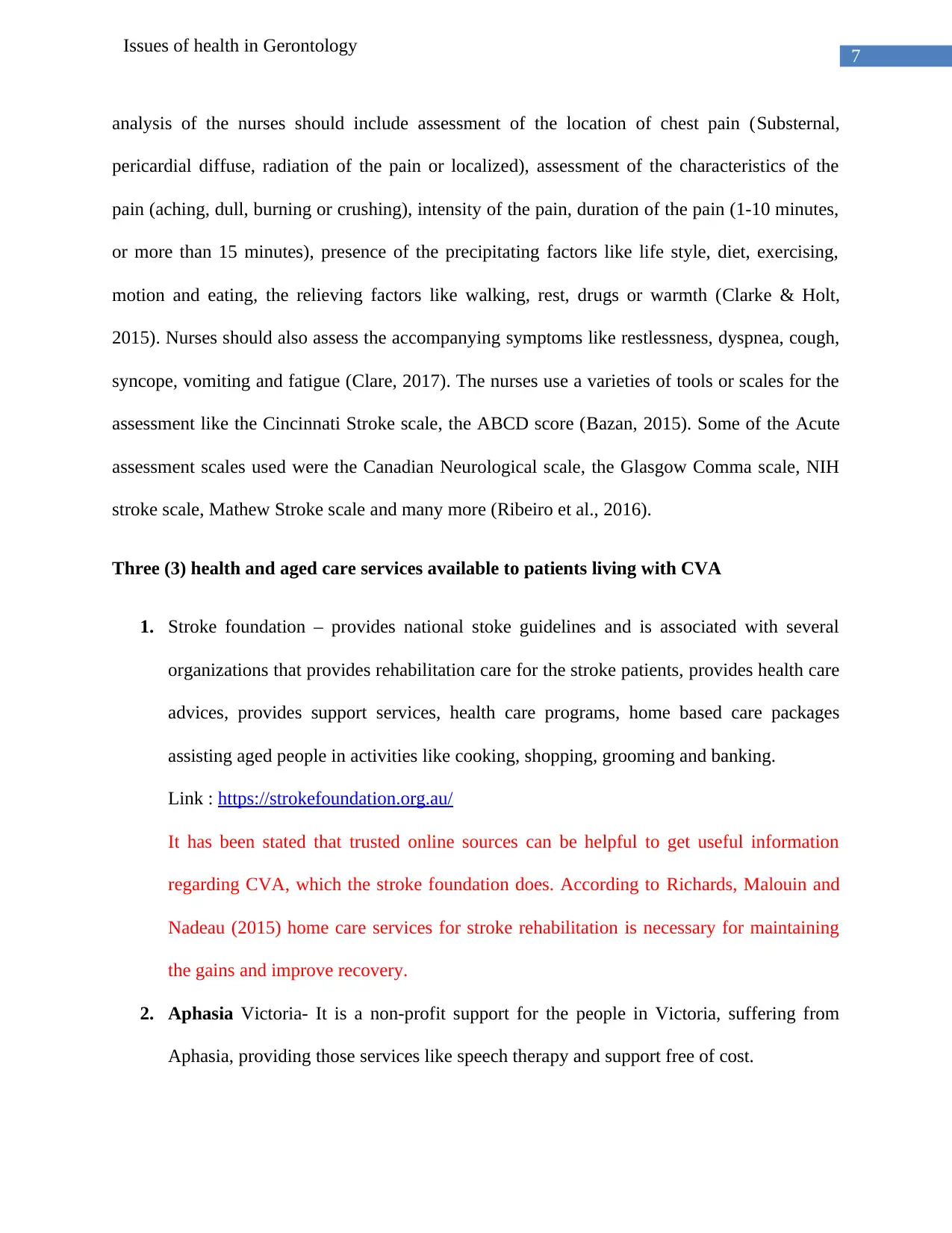
7
Issues of health in Gerontology
analysis of the nurses should include assessment of the location of chest pain (Substernal,
pericardial diffuse, radiation of the pain or localized), assessment of the characteristics of the
pain (aching, dull, burning or crushing), intensity of the pain, duration of the pain (1-10 minutes,
or more than 15 minutes), presence of the precipitating factors like life style, diet, exercising,
motion and eating, the relieving factors like walking, rest, drugs or warmth (Clarke & Holt,
2015). Nurses should also assess the accompanying symptoms like restlessness, dyspnea, cough,
syncope, vomiting and fatigue (Clare, 2017). The nurses use a varieties of tools or scales for the
assessment like the Cincinnati Stroke scale, the ABCD score (Bazan, 2015). Some of the Acute
assessment scales used were the Canadian Neurological scale, the Glasgow Comma scale, NIH
stroke scale, Mathew Stroke scale and many more (Ribeiro et al., 2016).
Three (3) health and aged care services available to patients living with CVA
1. Stroke foundation – provides national stoke guidelines and is associated with several
organizations that provides rehabilitation care for the stroke patients, provides health care
advices, provides support services, health care programs, home based care packages
assisting aged people in activities like cooking, shopping, grooming and banking.
Link : https://strokefoundation.org.au/
It has been stated that trusted online sources can be helpful to get useful information
regarding CVA, which the stroke foundation does. According to Richards, Malouin and
Nadeau (2015) home care services for stroke rehabilitation is necessary for maintaining
the gains and improve recovery.
2. Aphasia Victoria- It is a non-profit support for the people in Victoria, suffering from
Aphasia, providing those services like speech therapy and support free of cost.
Issues of health in Gerontology
analysis of the nurses should include assessment of the location of chest pain (Substernal,
pericardial diffuse, radiation of the pain or localized), assessment of the characteristics of the
pain (aching, dull, burning or crushing), intensity of the pain, duration of the pain (1-10 minutes,
or more than 15 minutes), presence of the precipitating factors like life style, diet, exercising,
motion and eating, the relieving factors like walking, rest, drugs or warmth (Clarke & Holt,
2015). Nurses should also assess the accompanying symptoms like restlessness, dyspnea, cough,
syncope, vomiting and fatigue (Clare, 2017). The nurses use a varieties of tools or scales for the
assessment like the Cincinnati Stroke scale, the ABCD score (Bazan, 2015). Some of the Acute
assessment scales used were the Canadian Neurological scale, the Glasgow Comma scale, NIH
stroke scale, Mathew Stroke scale and many more (Ribeiro et al., 2016).
Three (3) health and aged care services available to patients living with CVA
1. Stroke foundation – provides national stoke guidelines and is associated with several
organizations that provides rehabilitation care for the stroke patients, provides health care
advices, provides support services, health care programs, home based care packages
assisting aged people in activities like cooking, shopping, grooming and banking.
Link : https://strokefoundation.org.au/
It has been stated that trusted online sources can be helpful to get useful information
regarding CVA, which the stroke foundation does. According to Richards, Malouin and
Nadeau (2015) home care services for stroke rehabilitation is necessary for maintaining
the gains and improve recovery.
2. Aphasia Victoria- It is a non-profit support for the people in Victoria, suffering from
Aphasia, providing those services like speech therapy and support free of cost.
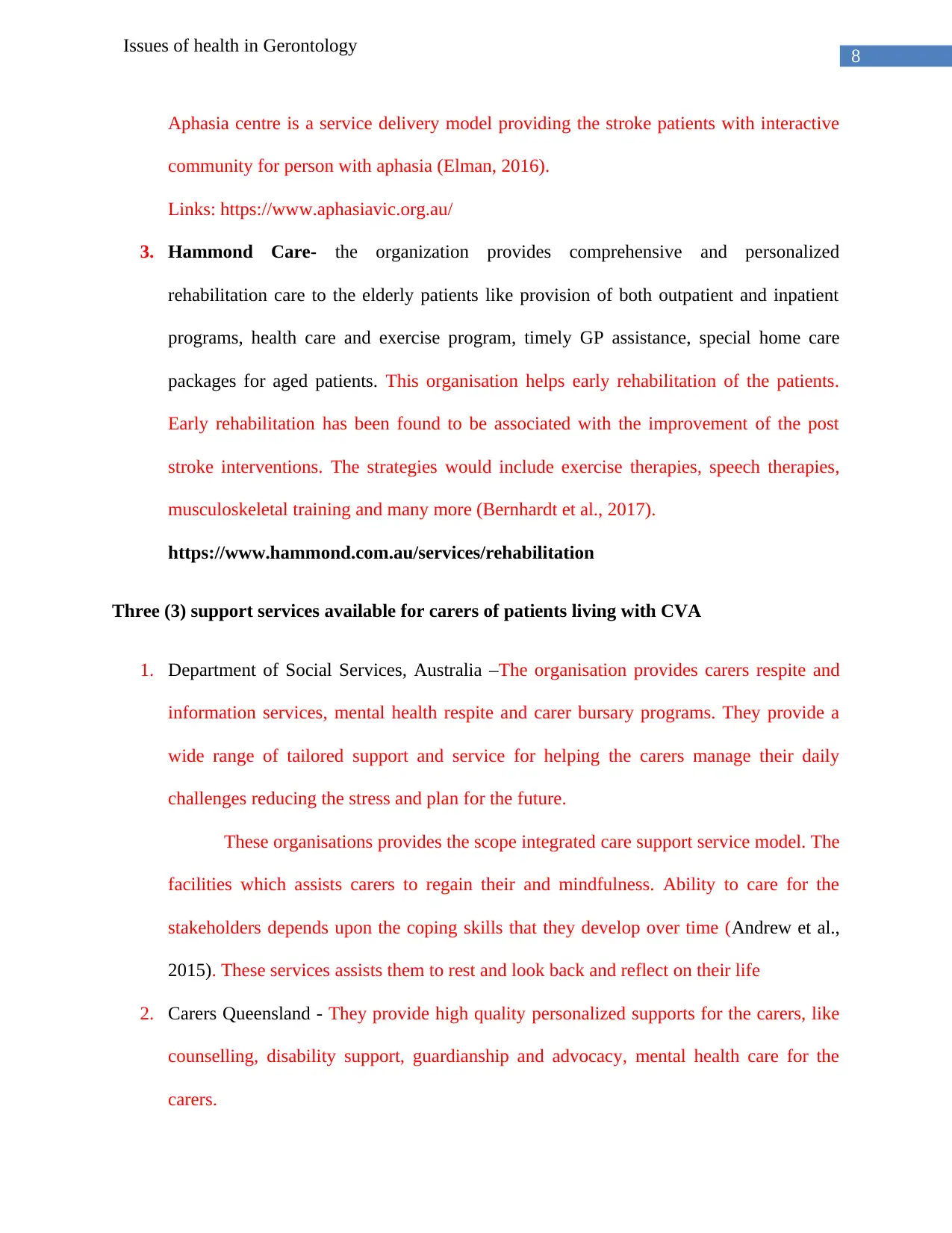
8
Issues of health in Gerontology
Aphasia centre is a service delivery model providing the stroke patients with interactive
community for person with aphasia (Elman, 2016).
Links: https://www.aphasiavic.org.au/
3. Hammond Care- the organization provides comprehensive and personalized
rehabilitation care to the elderly patients like provision of both outpatient and inpatient
programs, health care and exercise program, timely GP assistance, special home care
packages for aged patients. This organisation helps early rehabilitation of the patients.
Early rehabilitation has been found to be associated with the improvement of the post
stroke interventions. The strategies would include exercise therapies, speech therapies,
musculoskeletal training and many more (Bernhardt et al., 2017).
https://www.hammond.com.au/services/rehabilitation
Three (3) support services available for carers of patients living with CVA
1. Department of Social Services, Australia –The organisation provides carers respite and
information services, mental health respite and carer bursary programs. They provide a
wide range of tailored support and service for helping the carers manage their daily
challenges reducing the stress and plan for the future.
These organisations provides the scope integrated care support service model. The
facilities which assists carers to regain their and mindfulness. Ability to care for the
stakeholders depends upon the coping skills that they develop over time (Andrew et al.,
2015). These services assists them to rest and look back and reflect on their life
2. Carers Queensland - They provide high quality personalized supports for the carers, like
counselling, disability support, guardianship and advocacy, mental health care for the
carers.
Issues of health in Gerontology
Aphasia centre is a service delivery model providing the stroke patients with interactive
community for person with aphasia (Elman, 2016).
Links: https://www.aphasiavic.org.au/
3. Hammond Care- the organization provides comprehensive and personalized
rehabilitation care to the elderly patients like provision of both outpatient and inpatient
programs, health care and exercise program, timely GP assistance, special home care
packages for aged patients. This organisation helps early rehabilitation of the patients.
Early rehabilitation has been found to be associated with the improvement of the post
stroke interventions. The strategies would include exercise therapies, speech therapies,
musculoskeletal training and many more (Bernhardt et al., 2017).
https://www.hammond.com.au/services/rehabilitation
Three (3) support services available for carers of patients living with CVA
1. Department of Social Services, Australia –The organisation provides carers respite and
information services, mental health respite and carer bursary programs. They provide a
wide range of tailored support and service for helping the carers manage their daily
challenges reducing the stress and plan for the future.
These organisations provides the scope integrated care support service model. The
facilities which assists carers to regain their and mindfulness. Ability to care for the
stakeholders depends upon the coping skills that they develop over time (Andrew et al.,
2015). These services assists them to rest and look back and reflect on their life
2. Carers Queensland - They provide high quality personalized supports for the carers, like
counselling, disability support, guardianship and advocacy, mental health care for the
carers.
⊘ This is a preview!⊘
Do you want full access?
Subscribe today to unlock all pages.

Trusted by 1+ million students worldwide
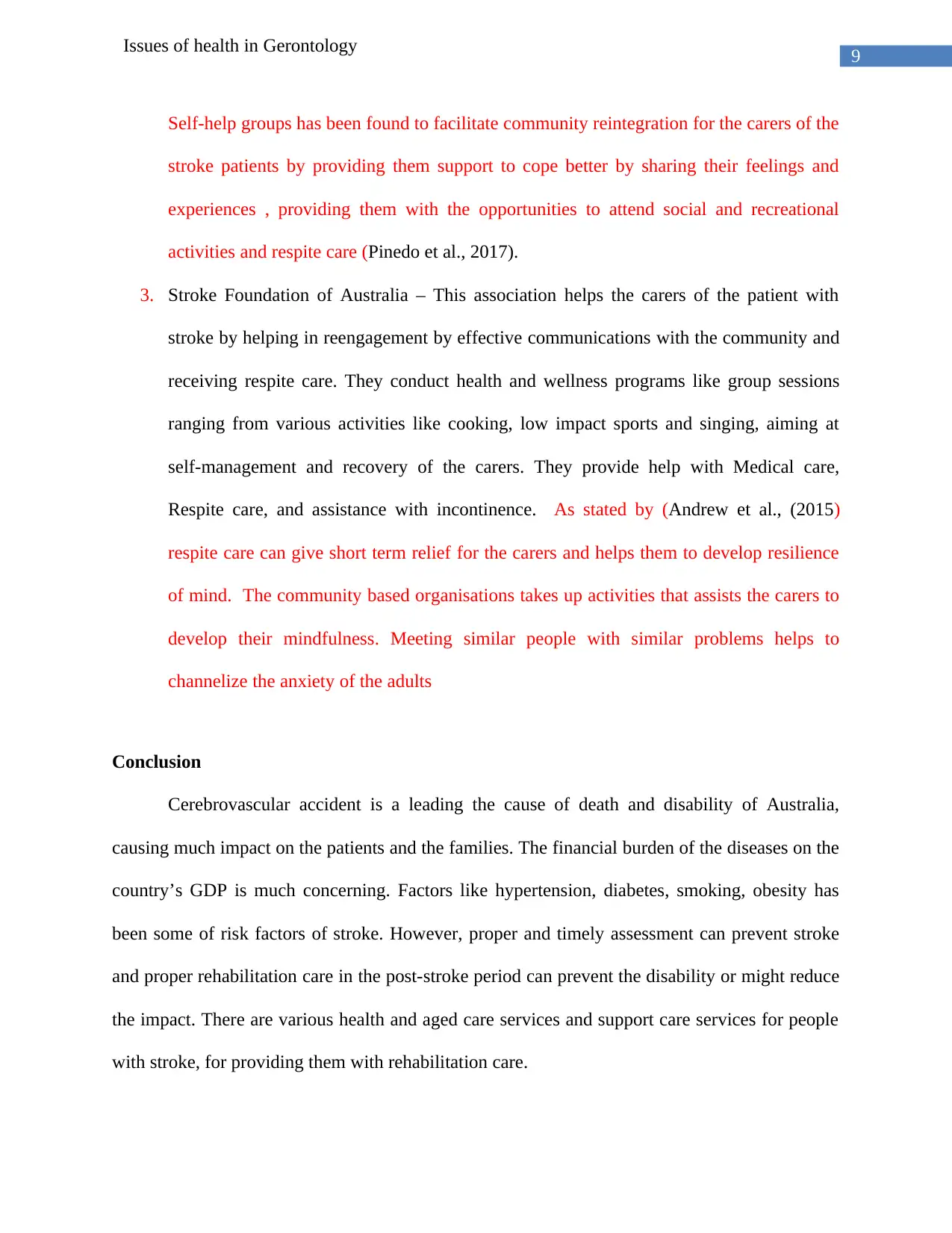
9
Issues of health in Gerontology
Self-help groups has been found to facilitate community reintegration for the carers of the
stroke patients by providing them support to cope better by sharing their feelings and
experiences , providing them with the opportunities to attend social and recreational
activities and respite care (Pinedo et al., 2017).
3. Stroke Foundation of Australia – This association helps the carers of the patient with
stroke by helping in reengagement by effective communications with the community and
receiving respite care. They conduct health and wellness programs like group sessions
ranging from various activities like cooking, low impact sports and singing, aiming at
self-management and recovery of the carers. They provide help with Medical care,
Respite care, and assistance with incontinence. As stated by (Andrew et al., (2015)
respite care can give short term relief for the carers and helps them to develop resilience
of mind. The community based organisations takes up activities that assists the carers to
develop their mindfulness. Meeting similar people with similar problems helps to
channelize the anxiety of the adults
Conclusion
Cerebrovascular accident is a leading the cause of death and disability of Australia,
causing much impact on the patients and the families. The financial burden of the diseases on the
country’s GDP is much concerning. Factors like hypertension, diabetes, smoking, obesity has
been some of risk factors of stroke. However, proper and timely assessment can prevent stroke
and proper rehabilitation care in the post-stroke period can prevent the disability or might reduce
the impact. There are various health and aged care services and support care services for people
with stroke, for providing them with rehabilitation care.
Issues of health in Gerontology
Self-help groups has been found to facilitate community reintegration for the carers of the
stroke patients by providing them support to cope better by sharing their feelings and
experiences , providing them with the opportunities to attend social and recreational
activities and respite care (Pinedo et al., 2017).
3. Stroke Foundation of Australia – This association helps the carers of the patient with
stroke by helping in reengagement by effective communications with the community and
receiving respite care. They conduct health and wellness programs like group sessions
ranging from various activities like cooking, low impact sports and singing, aiming at
self-management and recovery of the carers. They provide help with Medical care,
Respite care, and assistance with incontinence. As stated by (Andrew et al., (2015)
respite care can give short term relief for the carers and helps them to develop resilience
of mind. The community based organisations takes up activities that assists the carers to
develop their mindfulness. Meeting similar people with similar problems helps to
channelize the anxiety of the adults
Conclusion
Cerebrovascular accident is a leading the cause of death and disability of Australia,
causing much impact on the patients and the families. The financial burden of the diseases on the
country’s GDP is much concerning. Factors like hypertension, diabetes, smoking, obesity has
been some of risk factors of stroke. However, proper and timely assessment can prevent stroke
and proper rehabilitation care in the post-stroke period can prevent the disability or might reduce
the impact. There are various health and aged care services and support care services for people
with stroke, for providing them with rehabilitation care.
Paraphrase This Document
Need a fresh take? Get an instant paraphrase of this document with our AI Paraphraser

10
Issues of health in Gerontology
Issues of health in Gerontology
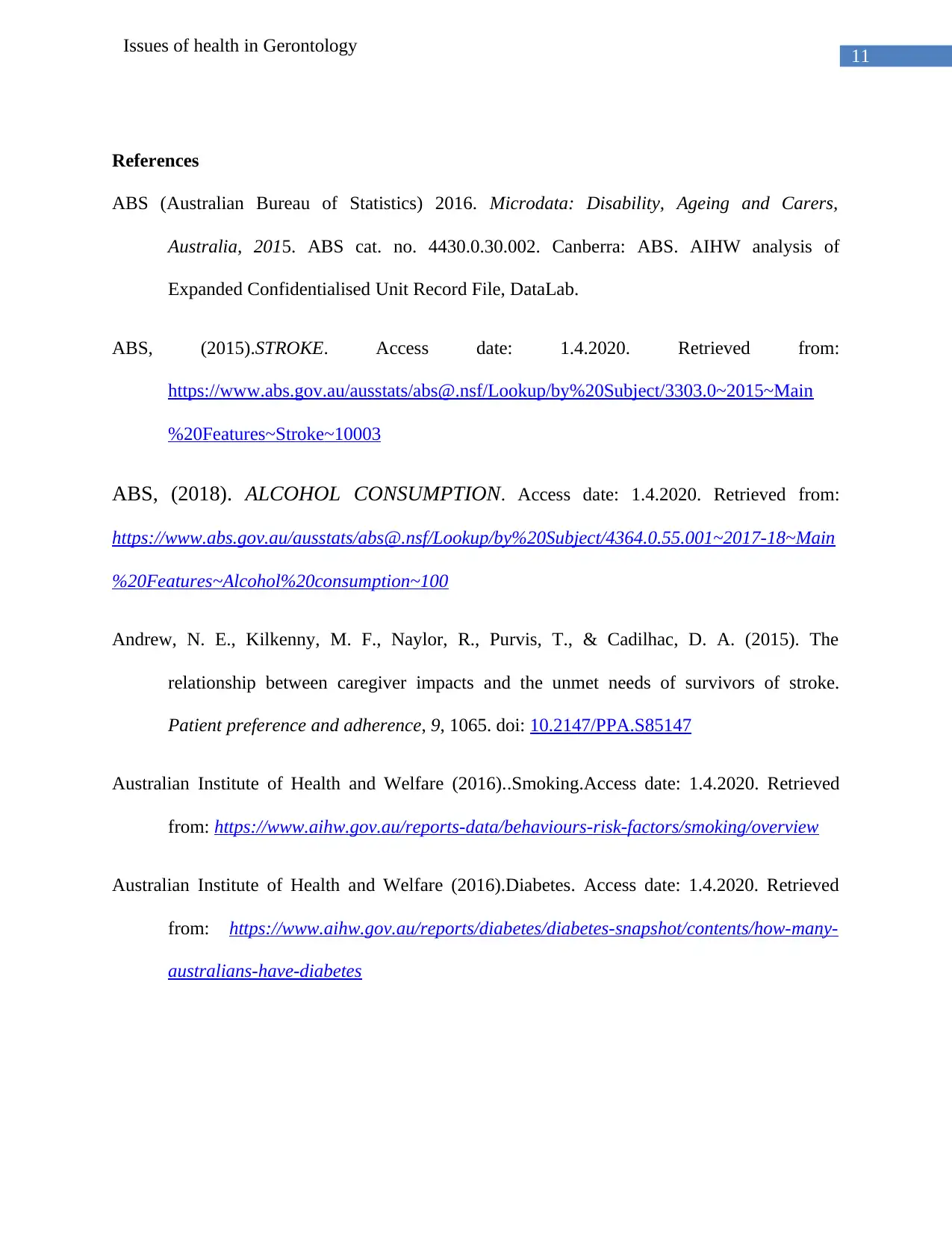
11
Issues of health in Gerontology
References
ABS (Australian Bureau of Statistics) 2016. Microdata: Disability, Ageing and Carers,
Australia, 2015. ABS cat. no. 4430.0.30.002. Canberra: ABS. AIHW analysis of
Expanded Confidentialised Unit Record File, DataLab.
ABS, (2015).STROKE. Access date: 1.4.2020. Retrieved from:
https://www.abs.gov.au/ausstats/abs@.nsf/Lookup/by%20Subject/3303.0~2015~Main
%20Features~Stroke~10003
ABS, (2018). ALCOHOL CONSUMPTION. Access date: 1.4.2020. Retrieved from:
https://www.abs.gov.au/ausstats/abs@.nsf/Lookup/by%20Subject/4364.0.55.001~2017-18~Main
%20Features~Alcohol%20consumption~100
Andrew, N. E., Kilkenny, M. F., Naylor, R., Purvis, T., & Cadilhac, D. A. (2015). The
relationship between caregiver impacts and the unmet needs of survivors of stroke.
Patient preference and adherence, 9, 1065. doi: 10.2147/PPA.S85147
Australian Institute of Health and Welfare (2016)..Smoking.Access date: 1.4.2020. Retrieved
from: https://www.aihw.gov.au/reports-data/behaviours-risk-factors/smoking/overview
Australian Institute of Health and Welfare (2016).Diabetes. Access date: 1.4.2020. Retrieved
from: https://www.aihw.gov.au/reports/diabetes/diabetes-snapshot/contents/how-many-
australians-have-diabetes
Issues of health in Gerontology
References
ABS (Australian Bureau of Statistics) 2016. Microdata: Disability, Ageing and Carers,
Australia, 2015. ABS cat. no. 4430.0.30.002. Canberra: ABS. AIHW analysis of
Expanded Confidentialised Unit Record File, DataLab.
ABS, (2015).STROKE. Access date: 1.4.2020. Retrieved from:
https://www.abs.gov.au/ausstats/abs@.nsf/Lookup/by%20Subject/3303.0~2015~Main
%20Features~Stroke~10003
ABS, (2018). ALCOHOL CONSUMPTION. Access date: 1.4.2020. Retrieved from:
https://www.abs.gov.au/ausstats/abs@.nsf/Lookup/by%20Subject/4364.0.55.001~2017-18~Main
%20Features~Alcohol%20consumption~100
Andrew, N. E., Kilkenny, M. F., Naylor, R., Purvis, T., & Cadilhac, D. A. (2015). The
relationship between caregiver impacts and the unmet needs of survivors of stroke.
Patient preference and adherence, 9, 1065. doi: 10.2147/PPA.S85147
Australian Institute of Health and Welfare (2016)..Smoking.Access date: 1.4.2020. Retrieved
from: https://www.aihw.gov.au/reports-data/behaviours-risk-factors/smoking/overview
Australian Institute of Health and Welfare (2016).Diabetes. Access date: 1.4.2020. Retrieved
from: https://www.aihw.gov.au/reports/diabetes/diabetes-snapshot/contents/how-many-
australians-have-diabetes
⊘ This is a preview!⊘
Do you want full access?
Subscribe today to unlock all pages.

Trusted by 1+ million students worldwide
1 out of 16
Related Documents
Your All-in-One AI-Powered Toolkit for Academic Success.
+13062052269
info@desklib.com
Available 24*7 on WhatsApp / Email
![[object Object]](/_next/static/media/star-bottom.7253800d.svg)
Unlock your academic potential
Copyright © 2020–2025 A2Z Services. All Rights Reserved. Developed and managed by ZUCOL.





